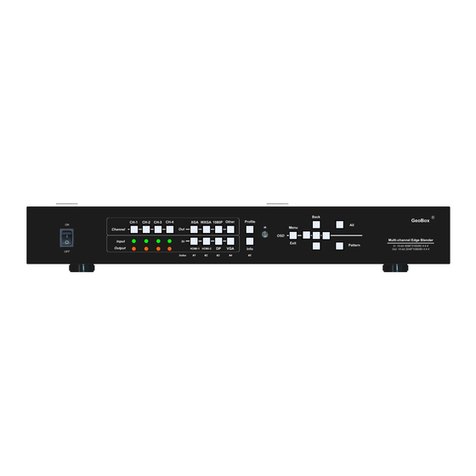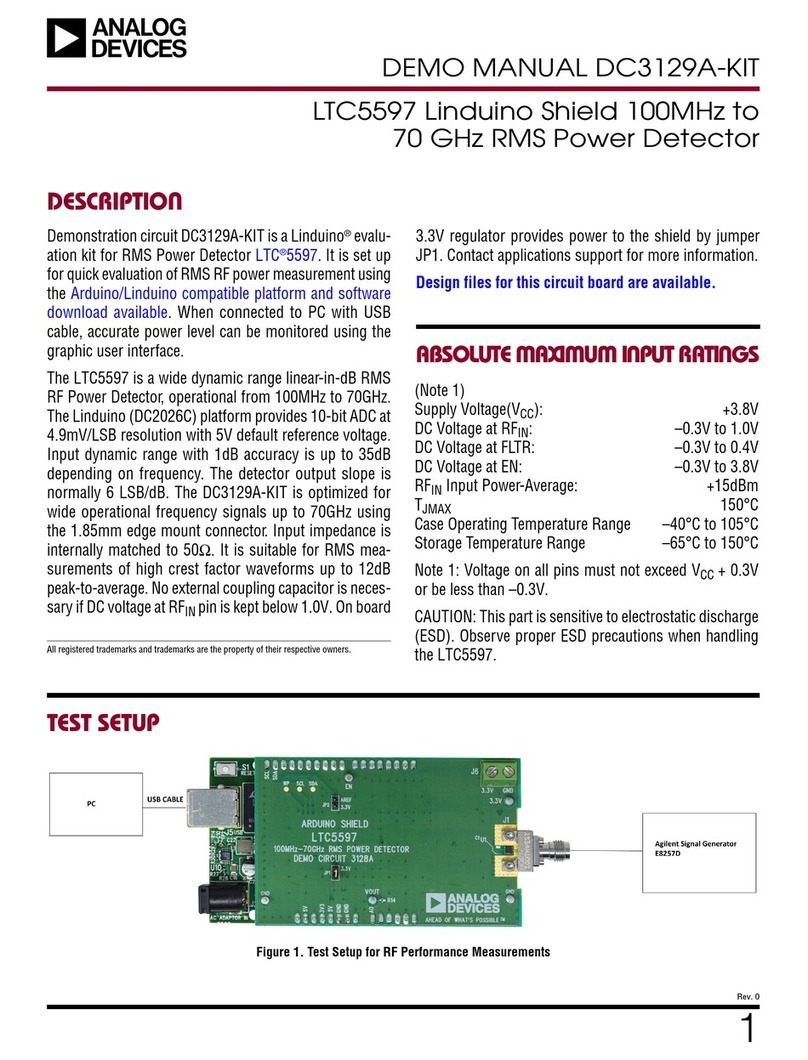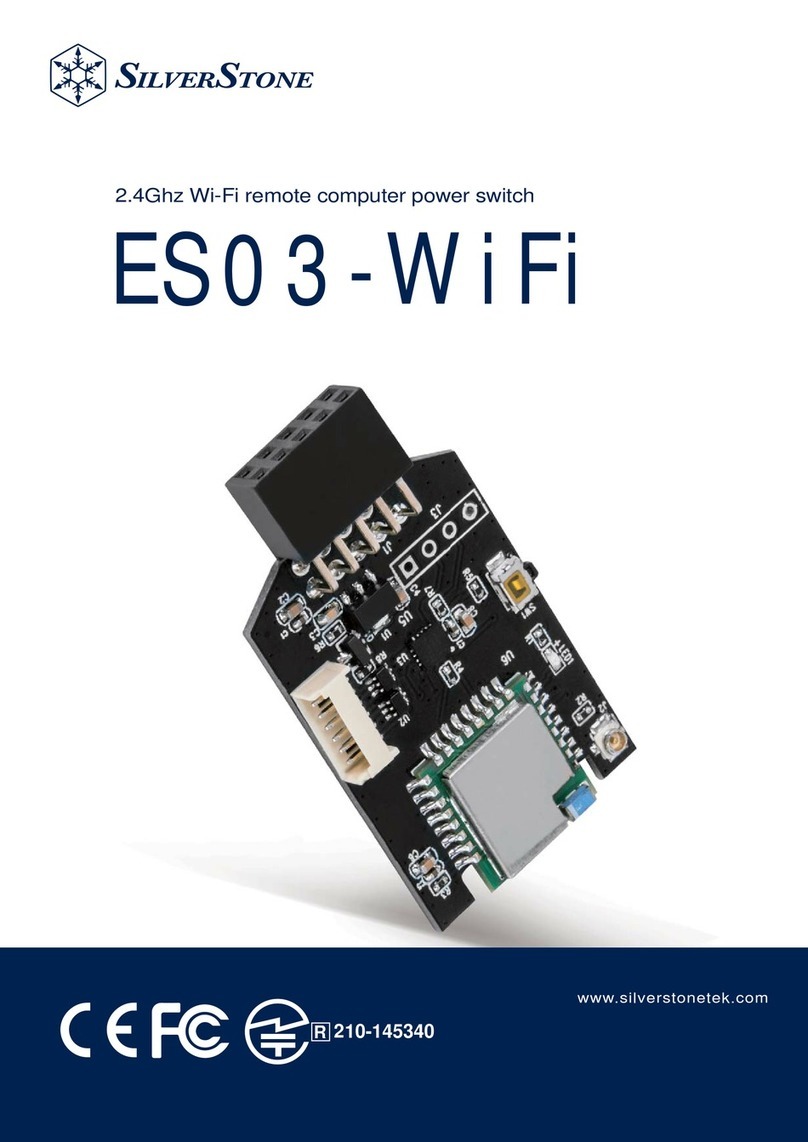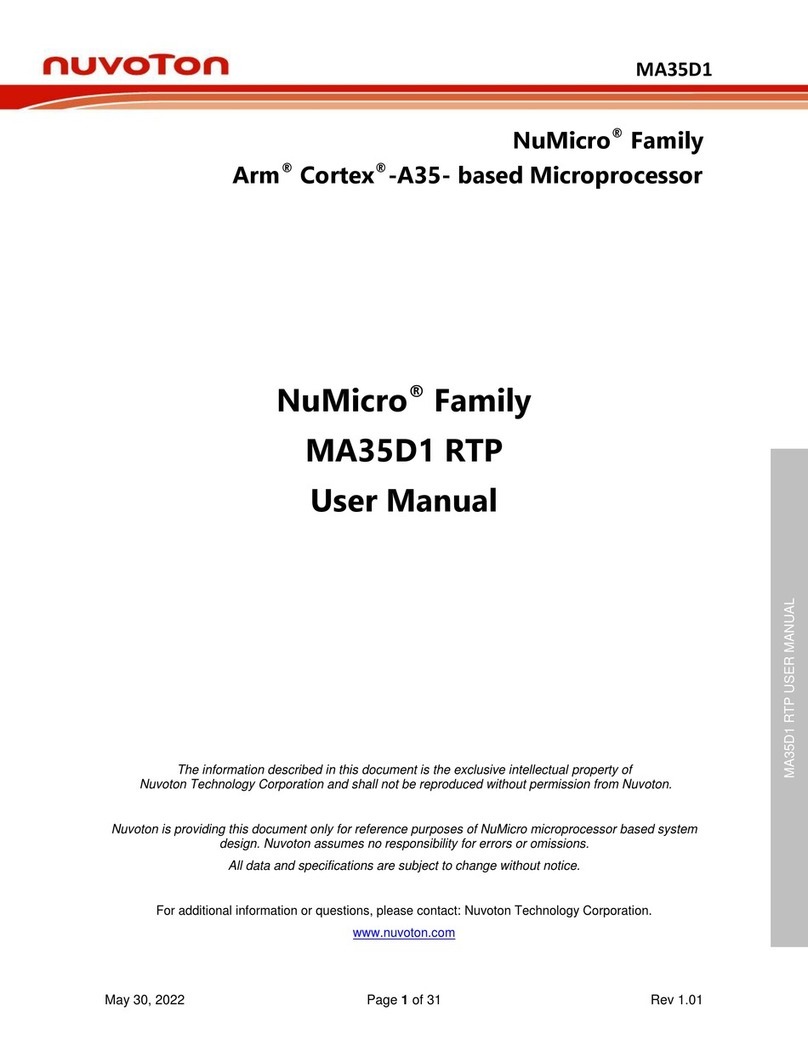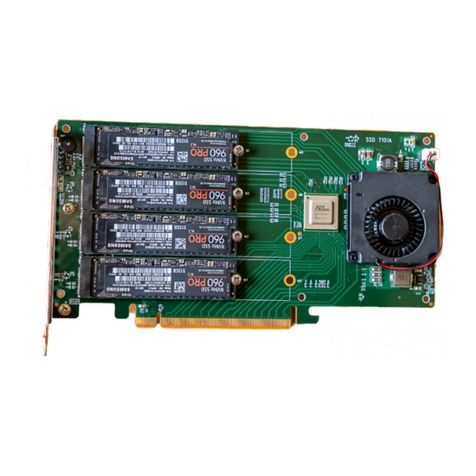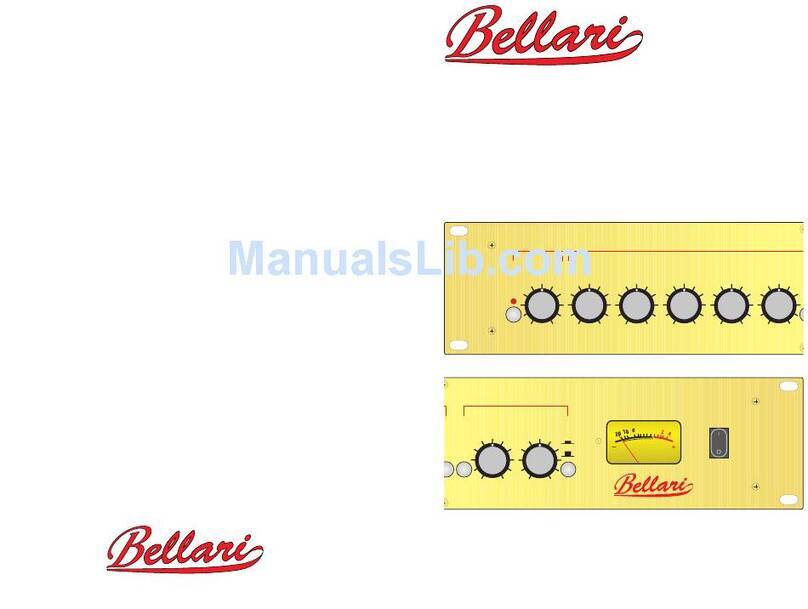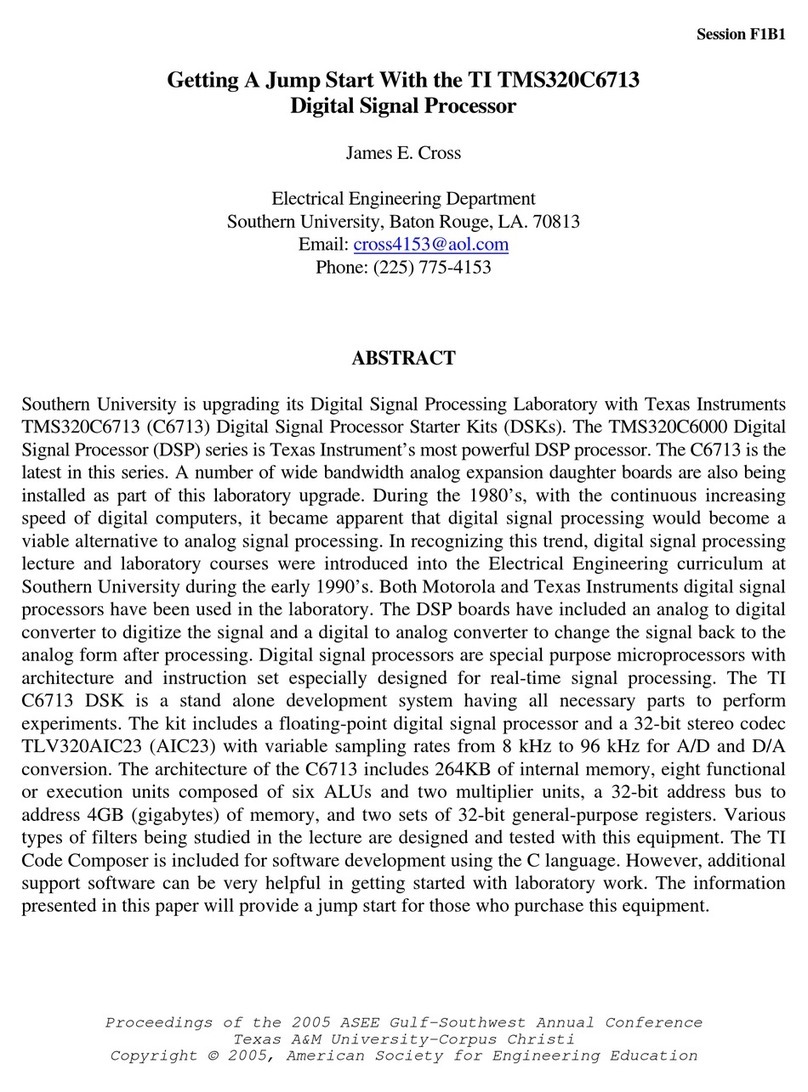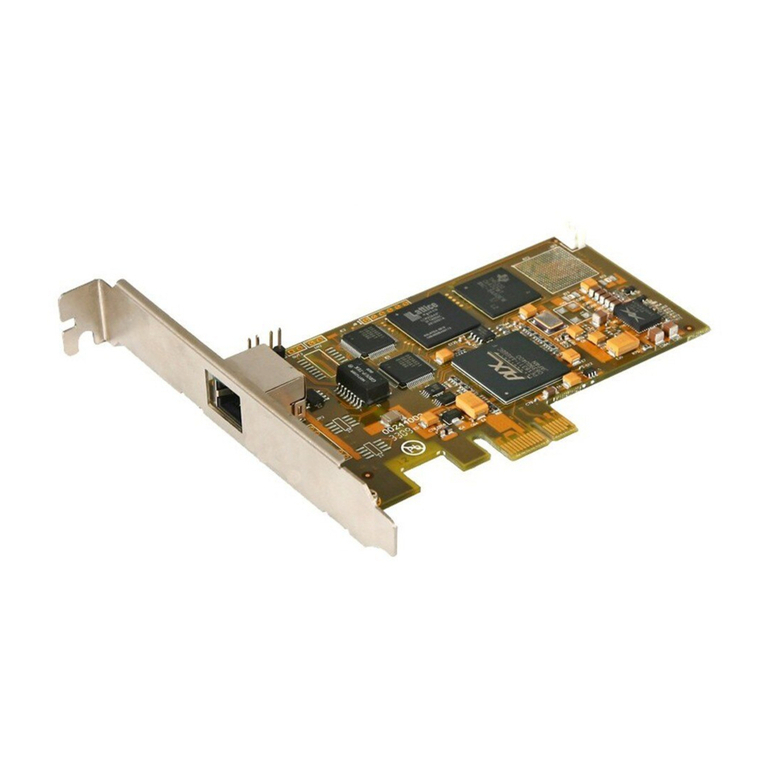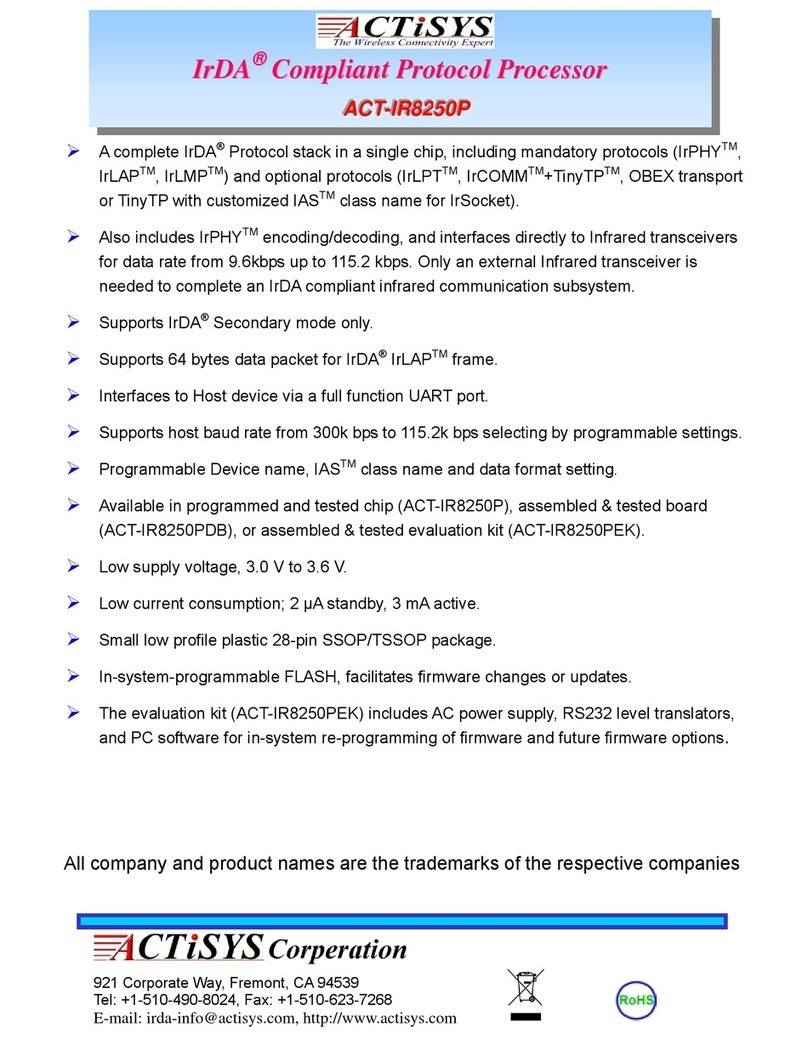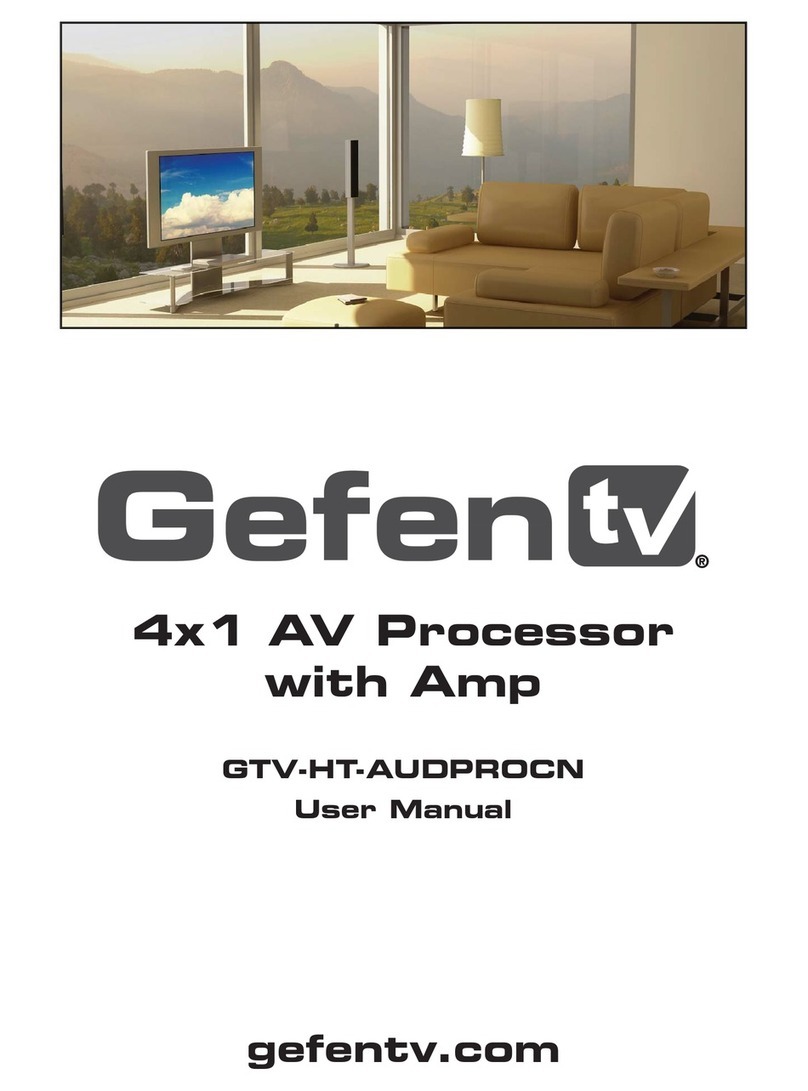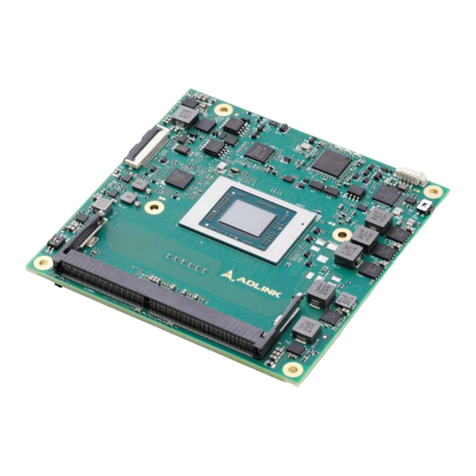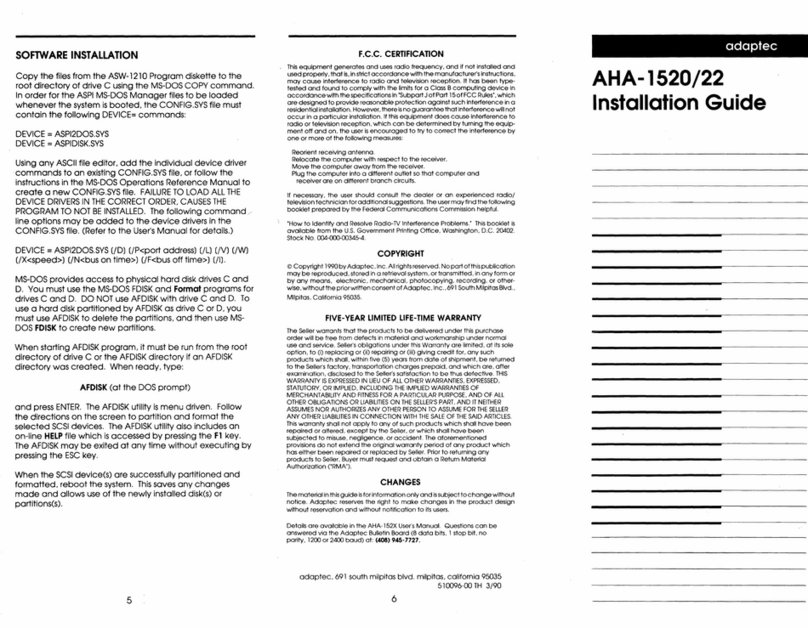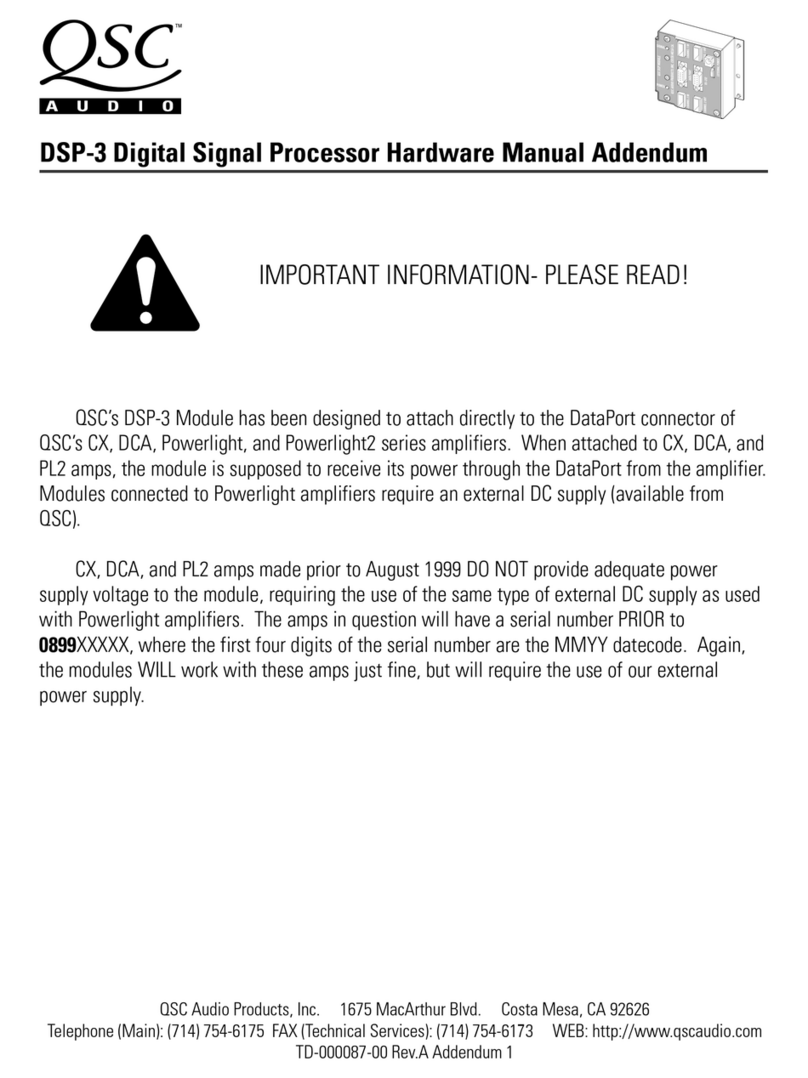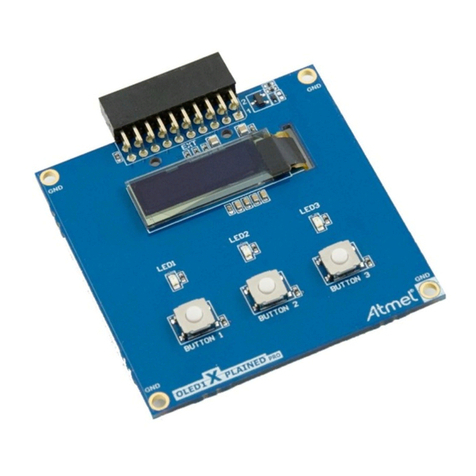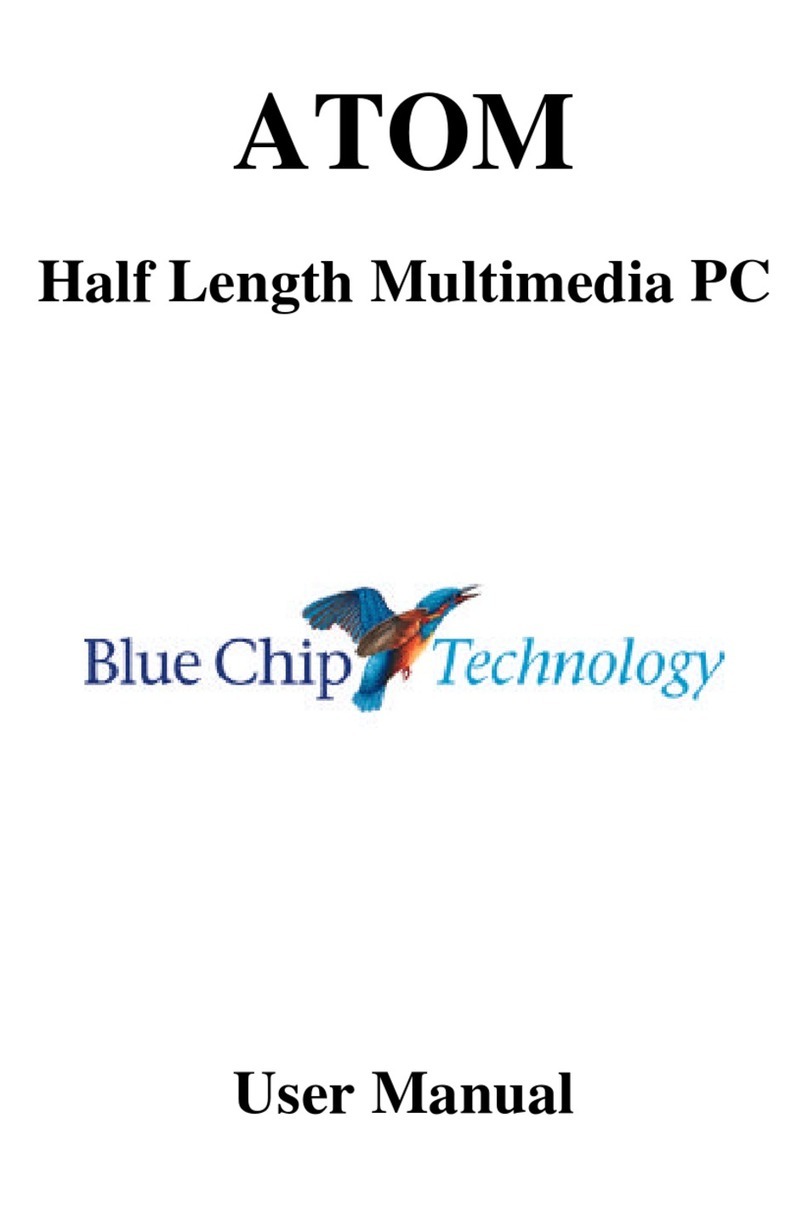GeoBox M800 User manual

M800 User Guide Document: M800-3
-----------------------------------------------------------------------------------------------------------------------------------------------
-
0
M800 Edge Blending processor User Guide
Technical support:
Tel: +886-2-2792-2819 Cell: +886-935-678-033
Skype: vns-inc
Version: 1.1
Website: www.vnstw.com
The absolute opposite of ordinary
DCi/UHD
4k/60/4:4:4
HDMI 2.0
DisplayPort 1.2
HDCP
2.2/1.4
HDR
Ready
10-bit
High-end
scaler
Cadence
Film 3:2 / 2:2
3D Motion
De-interlace
Deep Color
xvYCC/12-bit
Edge Blend
RGB separate
Gamma
Corner wall
Geometry
Alignment
Multi-Unit
Cascade
Multi-view
Discrete display
Flexible
Aspect Ratio
Rotation
Landscape
Protrait
Loop Out
Daisy chain
Control
IR/USB/RS232
/Ethernet
Video wall
Embedded
Input: up to 4096*2160 @60Hz 4:4:4 full color sampling
Output: 2048*1080 @60Hz
New generation Warp & Edge blending engine
Full functions in one box, simple, easy-of-use
with matrix SW function
M801 (1 CH), M802 (2 CH), M803 (3 CH), M804 (4 CH)
with matrix SW function

M800 User Guide Document: M800-3
-----------------------------------------------------------------------------------------------------------------------------------------------
-
1
Table of Contents
Disclaimer/Copyright Statement.......................................................................................................... 3
Warranty/RMA………………………………………………………………………………………………… 3
FCC/CE Statement............................................................................................................................... 3
Introduction……………………………………………………………....................................................... 4
Specification…………………………………………………………………………………………………… 6
Functions and Features....................................................................................................................... 7
1. Content in the packing box............................................................................................................ 10
2. Basic operation & settings………………………………………………………………………………. 10
2.1. Connecting the Inputs.........………………………………………….…..................................... 10
2.2. Connecting the Outputs....................................................…………....................................... 10
2.3. Input / Output Selection & LED indicators.........…………………………………………………. 11
2.4. System Connection and Power On.......…………………………………………………………… 13
2.5. HDMI Loop Out for daisy chain connection..............……………….………………………….... 14
2.6. System Settings: Box ID, RS232, Ethernet............................................................................. 14
2.7. How to use IR Remote Controller........................................................................................... 16
2.8. Full screen and native aspect ratio………………………………………………………………… 17
2.9. Image rotation and flip………………………………………………………………………………. 17
2.10. Global Color adjustment…………………………………………………………………………… 18
2.11. OSD Lock and unlock……………………………………………………………………………… 19
2.12. System synchronization…………………………………………………………………………… 19
2.13. Dual window display—PIP/POP (Picture in picture & side by side) …………………………. 20
2.14. Image Orientation (Flip & Rotation) ……………………………………………………………… 22
3. Project plan and preparation for edge blending………………………………………………………… 23
3.1. Determine source signal resolution………………………………………………………………... 23
3.2. Determine overlap region size and pixels…………………………………………………………. 23
3.3. Relation between Overlap pixels and geometry alignment accuracy…………………………. 24
3.4. Get installation data from VNS Excel Spread Sheet……………………………………………… 25
3.5. Apply Spread Sheet data for projector installation and GeoBox setting………………………. 27
3.6. Projector settings before edge blending…………………………………………………………… 28
3.7. GeoBox settings before edge blending…………………………………………………………… 29
4. Geometry Alignment………………………………………………………………………………………. 29
4.1. Select the right Grid Pattern for geometry alignment……………………………………………. 29
4.2. Grid pattern pixel size selection……………………………………………………………………. 30
4.3. Geometry alignment………………………………………………………………………………… 31
4.3.1.Geometry alignment through remote controller……………………………………………. 32
4.3.2.Activate grid pattern…………………………………………………………………………… 32
4.3.3.[2x2] 4 corner geometry alignment…………………………………………………………… 32
4.3.4.[3x3], [5x3], [9x5] warp alignment……………………………………………………………. 33
4.3.5.Linearity grid line adjustment…………………………………………………………………. 35
4.3.6.Corner [Wall] geometry adjustment…………………………………………………………… 36
4.3.7. [Gwarp3] PC Tool ...……………………………………………………………………………. 38
5. [Video Wall] settings………………………………………………………………………………………. 39
5.1. [Zoom]: split the signal source……………………………………………………………………… 40

M800 User Guide Document: M800-3
-----------------------------------------------------------------------------------------------------------------------------------------------
-
2
5.2. [Pan]: assign image location………………………………………………………………………… 40
5.3. [Overlap]: crop the right image for each projector………………………………………………… 41
5.4. [Position]: shift image position without changing image size……………………………………. 41
6. [Edge Blend] settings……………………………………………………………………………………… 41
6.1. [Edge] selection location and set edge blending value…………………………………………. 42
6.2. [Shift]: shift image position and execute Edge Mask……………………………………………. 43
6.3. [Gamma]: color correction in edge blending area……………………….………………………. 43
6.4. Black level uplift: [Offset] & [Corner] adjustment………………………………………………… 45
6.5. [Color]: Individual projector white balance and color correction………………………………. 47
6.6. Edge [Mask]…………………………………………………………………………………………. 48
6.7. [Grid] (More details in Section 4.2) ………………………………………………………………. 50
6.8. Final image quality fine-tuning………………………………………………………………….…. 50
7. Example for 3 projector edge blending procedures.…………………………………………………. 51
7.1. Get detailed edge blending information through VNS Excel Spread Sheet…………………. 51
7.2. Mark image location and install the projectors…………………………………………………… 52
7.3. System connection…………………………………………………………………………………. 52
7.4. Projector settings…………………………………………………………………………………… 53
7.5. GeoBox settings……………………………………………………………………………………… 53
7.6. Geometry alignment………………………………………………………………………………… 54
7.7. Video wall settings…………………………………………………………………………………… 56
7.8. Edge blending setting………………………………………………………………………………… 57
7.9. Final image quality fine-tuning……………………………………………………………………… 58
8. Save/Load system settings………………………………………………………………………………. 58
9. Multiple unit applications…………………………………………………………………………………. 59
9.1. System connection in multiple unit edge blending………………………………………………. 59
9.2. Content overlap setting issue ……………………………………………………………………… 61
9.3. Convenient setting in multiple unit application……………………………………………………. 63
9.3.1.Setup by remote controller…………………………………………………………………… 63
9.3.2.Setup by Ethernet……………………………………………………………………………… 63
10. WebGui and Gwarp3 PC tool……………………………………………………………………………... 64
10.1. WebGui ……………………………………………………………………………………………… 64
10.2. Gwarp3 PC Tool ……………………………………………………………………………………. 65
11. Advanced applications and settings……………………………………………………………………… 65
11.1. Immersive display with multiple projectors……………………………………………………… 65
11.2. Portrait edge blending……………………………………………………………………………. 67
11.3. Flexible display……………………………………………………………………………………… 68
11.4. Discrete content displayed in each projector……………………………………………………. 69
11.5. Complete system aspect ratio adjustment………………………………………………………. 70
12. Miscellaneous settings……………………………………………………………………………………. 71
12.1. Helpful tips for edge blending……………………………………………………………………. 71
12.2. EDID settings………………………………………………………………………………………… 72
12.3. HDMI vs. DVI output signal………………………………………………………………………… 73
12.4. System standby and automatically turn off output signal………………………………………. 73
12.5. Change background color…………………………………………………………………………. 73
12.6. Turn off Splash screen Logo………………………………………………………………………. 74
12.7. Limitation in image flip and rotation………………………………………………………………. 74

M800 User Guide Document: M800-3
-----------------------------------------------------------------------------------------------------------------------------------------------
-
3
12.8. Limitation in audio output…………………………………………………………………………. 74
13. Trouble shooting…………………………………………………………………………………………… 74
13.1. Front panel LED indicators………………………………………………………………………... 74.
13.2. Intermittent or loss of input signal………………………………………………………………... 74
13.3. Video quality issues………………………………………………………………………………… 75
13.4. Image position shift after installation……………………………………………………………… 75
13.5. System crash and malfunction ……………………………………………………………………. 76
13.6. Synchronization issue in the outputs……………………………………………………………… 76
14. Technical support…………………………………………………………………………………………… 77
15. Safety precaution and maintenance……………………………………………………………………… 77
Specification ……………………………………………………………………………………………………... 79
Revision History…………………………………………………………………………………………………… 80
Disclaimer/Copyright Statement
Copyright 2018, VNS Inc. All Right Reserved
This information contained in this document is protected by copyright. All rights are reserved by VNS Inc.
VNS Inc. reserves the right to modify this document without any obligation to notify any person or entity of such revision. Copying,
duplicating, selling, or otherwise distributing any part of this document without signing a non-disclosure agreement with an authorized
representative of VNS Inc. is prohibited. VNS Inc. makes no warranty for the use of its products and bears no responsibility for any error of
omission that may appear in this document.
Product names mentioned herein are used for identification purposes only and may be trademarks of their respective companies.
Limited Warranty and RMA statement
This device is designed and tested to the highest standards and backed by two years’ parts and labor warranty. Warranties are effective upon
the first delivery date to the end customer and are non-transferable. Warranty related repairs include parts and labor, but do not include
repair of faults resulting from user negligence, special modifications, abuse (mechanical damage), shipping damage, and/or other unusual
damages. The customer shall pay shipping charges when the unit is returned for repair. Manufacturer will pay shipping charges for return
shipments to customers.
Manufacturer does not assume responsibility for consequential damages, expenses or loss of revenue, inconvenience or interruption in
operation experienced by the customer. Warranty service shall not automatically extend the warranty period.
User can pay extension fee to extend the warranty period. Please contact us for more details. In the event that a product needs to be returned
for repair, inform manufacturer and ask for a Return Material Authorization number.
FCC/CE statement
Note: This equipment has been tested and found to comply with the limits for a Class A digital device, pursuant to Part 15 of FCC Rules. These
limits are designed to provide reasonable protection against harmful interference in a residential installation. This equipment generates,
uses and can radiate radio frequency energy and, if not installed and used in accordance with the instruction, may cause harmful
interference to radio communications. However, there is no guarantee that interference will not occur in a particular installation. If this
equipment does cause harmful interference to radio or television reception, which can be determined by turning the equipment off and on,
the user is encouraged to try to correct the interference by one or more of the following measures:
•Reorient or relocate the receiving antenna.
•Increase the separation between the equipment and receiver.
•Connect the equipment into an outlet on a circuit different from that to which the receiver is connected.
•Consult the dealer or an experienced radio/TV technician for help.
Notice:
(1) An Unshielded-type power cord is required in order to meet FCC emission limits and also to prevent interference to the nearby radio and
television reception. It is essential that only the supplied power cord by used.
(2) Use only shielded cables to connect I/O devices to this equipment.
(3) Changes or modifications not expressly approved by the party responsible for compliance could void the user’s authority to operate the
equipment.

M800 User Guide Document: M800-3
-----------------------------------------------------------------------------------------------------------------------------------------------
-
4
Introduction
M800 is curved screen edge blending processor with the ability to provide multiple processing modules
to control from 1 to 4 projectors based on user’s requirements. M801 is designed with one processing module
to control one projector, M802 for 2 projectors, M803 for 3 projectors and M804 for 4 projectors. It was
designed for sophisticated edge blending as well as image warping, stacking and projection mapping…etc.
One M804 can execute 4 projector edge blending without any additional equipment or splitter. Two M804 can
control up to 8 projectors. More M800 can be cascaded for large scale display.
4 input ports (2x HDMI, 1x DP, 1x VGA) and 1x HDMI outputs are designed in each processing
module. Digital input supports up to 4096*2160 @60Hz with 4:4:4 full color sampling. Output supports up to
2048*1080 @60Hz. It is integrated with 10-bit high end processor, motion adaptive de-interlace, low angle
smooth algorithm, 3:2/2:2 pull-down and supports non-VESA standard input timing. Programmable EDID can
optimize input timing to get the best video result.
Advanced warp technology is embedded in M800. User can use IR controller, USB, Web Gui and
Ethernet to perform edge blending and sophisticated geometry alignment up to 17x17 control points. Linearity
Grid Line Adjustment and Corner Wall image adjustment for mapping image at 90 degrees corner is a new
function in geometry alignment. Separate R, G, B gamma correction for edge blending region color fine-tune,
individual global color correction for each output, fine pixel color uniformity and 9 regions non-edge blending
area black level uplift are also standard functions in M800. Users can see real time geometry and color
adjustment to get optimized result.
Image 90/180/270 degrees rotation and flip with 4k/60 input from various input sources are embedded
in M800. It provides more flexible system configuration ability.
HDMI loop out supports daisy chain connection up to 4096x2160 @60Hz and allows large display with
multiple M800 cascaded. Video wall function in M800 is to crop and allocate source image for each projector
and set overlap pixels for edge blending. Complete curved edge blending can be achieved through remote
controller and Ethernet without PC software, video distributor and splitter.
PIP (picture in picture) and POP (side by side) are standard functions in M800. PIP image size is from
320*180 up to 1920*1200. In one M804, user can display up to 8 different input contents on the screen.
M800 is an ideal solution for simulation. It can connect with inputs from multiple PCs and combine them
into one seamless image. It also provides flexible displays in edge blending system. For a 3x projector edge
blending system, user can configure as 1+1+1 independent display, 1+2 (two projectors blended) and all-in-
one (three projectors blended). User can also execute edge blending with projector at portrait position without
rotating source image to increase image height. It is a good fit with laser projector without the limitation in
installation angle.
Using M800, users can replace high end projector with low cost projector without lens shift, warp and
edge blending. It provides easy configuration, low entry barrier, cost effective, reliable and flexible solution.

M800 User Guide Document: M800-3
-----------------------------------------------------------------------------------------------------------------------------------------------
-
5
M801 (1 CH)
M802 (2 CH)
M803 (3 CH)
M804 (4 CH)
(The back panel shows 4 CH model—M804)

M800 User Guide Document: M800-3
-----------------------------------------------------------------------------------------------------------------------------------------------
-
6
Specification
Each box has 1-4 processing modules.
- M801: Single module processor
- M802: Dual module processor
- M803: Triple module processor
- M804: Quad module processor
Each processing module includes:
- Input: 2x HDMI 2.0b, 1x DP1.2a and 1x VGA
- Output: 1x HDMI
- Loop output: 1x HDMI 2.0 for cascade.
HDCP: HDMI V2.2/V1.4, DP: HDCP: V1.3
Max. input resolution: 4096x2160 60fps
Output: HDMI up to 2048x1080/60, output
signal is RGB 4:4:4 progressive.
New generation warp engine for geometry
alignment up to 17x17 grid control points.
Maximum geometry adjustment up to 1200
pixels in both H&V directions.
Edge blending at 4 edges up to H=1920
pixels, V=1200 pixels with independent R, G,
B gamma correction.
9 regions black level uplift to compensate light
leakage from projector optical system.
Support Corner Wall adjustment in H&V at
flexible location.
Support Linearity Grid Line adjustment for
quick H&V line position alignment.
Embedded video wall function for image split,
cropping and edge blend overlap pixel setting.
Support non-VESA standard input timings for
easy connection with various signal sources.
Selectable output up to 2048*1080 60Hz.
Selectable grid pattern size from 8-120 pixels
in H&V direction. Default is 32*32 pixels.
Selectable grid pattern color with optional
transparency to see background image.
Flexible aspect ratio adjustment in each edge
up to +_ 1800 pixels position shift.
Frame lock function to get perfect
synchronized outputs in all channels.
Frame rate conversion and 50Hz in/out
function to eliminate image frame repeat.
Three synchronization method: phase lock, frame
lock & free-run modes.
Free-run mode provides continuous signal to
projector, no source searching required when
timing change.
10-bit processor, 3:2/2:2 cadence, low angle
smooth algorithm, high quality scaling engine.
4:4:4 Chroma sampling, 30 Color bits, 12-bit RGB
gamma CLUT.
Support sRGB & xvYCC color processing &
8/10/12-bit deep color.
3D motion adaptive de-interlace.
High Dynamic Range (HDR) support: SMPTE ST-
2084, SMPTE ST-2086
Individual color and white balance adjustment in
each processing channel.
Individual 90/180/270 rotation, flip, cropping,
scaling & color adjustment in each channel up to
4k/60 input.
PIP/POP function with PIP image size from
320*180 up to 1920*1200 resolution with flexible
position and selectable aspect ratio. This function is
not available when the main image is 90/270
degrees rotation.
Embedded HDMI audio outputs.
Selectable and programmable EDID.
ESD Protection: ±8kV (Air-gap discharge), ±4kV
(Contact discharge)
Power supply: AC In: 100V-240V, DC Out: 12V 3A
Max. Power consumption: max. 28w (M804)
Working environment: 45〫C, 10-90% RH
Control: keypads, IR, RS232, USB, Ethernet
System settings can be stored and backup.
Dimensions:
M801: 303mm*180mm*45mm, weight: 1.8kg
M802-M804: 440mm*180mm*55mm
Weight: 2.4kg-2.8kg
CE/FCC/RoHS/Reach Certified
2 Year Warranty, paid extension available up to 5
years.

M800 User Guide Document: M800-3
-----------------------------------------------------------------------------------------------------------------------------------------------
-
7
Function and features:
A. Structure
Each M800 consists of 1-4 processing modules. Each processing module can control one projector and
multiple processing modules can be cascaded to control big scale display system.
B. Each processing module includes below input and output ports
1. Input: 2x HDMI, 1xVGA, 1x DisplayPort。
- HDMI & DisplayPort support 4096*2160 @60Hz, 3840*2400 @60Hz with 4:4:4 chroma sampling
without compression. VGA supports up to WUXGA or 205MHz analog input signal.
- Connect with various video sources and support none VESA standard input resolution up to 120Hz.
2. Output: 1x HDMI. Selectable output resolutions: 720x480、XGA、WXGA、1280x1024、1366x768、
1400x1050、1600x1200、1920x1080 (24/30/50/60Hz)、1920*1200/60、2048x1080/60。All output
are RGB 4:4:4 progressive signals.
3. Loop out port: 1x HDMI, same as source signal up to 4096*2160@60Hz & 3840x2400@60Hz.
C. Image warp, geometry alignment and edge blending
1. Selectable grid pattern size for geometry alignment from 8-120 pixels in H&V. Default is 32*32 pixels.
2. With full functions for quick 4 corner alignment, vertical and horizontal keystone correction, Pincushion
& Barrel adjustment, image warp and image 90/180/270 degrees rotation and flip.
3. Each module controls one projector and can be cascaded to control unlimited number of projectors.
4. Integrated with full function front panel keypads & IR remote controller for manual geometry alignment
through OSD up to 9*5 grid patterns with +_ 1200 pixels adjustment range at each corner. 3x3 edge
center geometry alignment range is limited to +_600 pixels in full HD output in top edge and both side
edges. Bottom edge is limited to 300 pixels. In most of curved screen edge blending system, the
projector will be installed at ceiling position, the lower position of the image has more distortion and will
be at top edge of GeoBox. It can match +_600 pixels adjustment range without problem.
5. Gwarp3 PC tool is available for warp and geometry alignment up to 17x17 grid patterns through USB or
Ethernet. The geometry alignment range is the same as manual adjustment. After finishing geometry
alignment, the parameters will be stored inside GeoBox and no more PC tool is needed.
6. Corner wall geometry alignment at 90 degrees corner wall up to 900 pixels adjustment range in H&V
directions. The adjustment point can be changed up to 900 pixels in H&V directions.
7. 4 directions edge blending up to H=1920, V=1200 overlapped pixels for flat, dual curved & cylindrical
screens.
8. Independent R, G, B gamma correction for edge blending color fine.
9. Precise black level uplift at multiple areas (up to 9) to compensate light leakage in the projector optical
system in dark environment.
10.White balance and individual color correction for each projector.

M800 User Guide Document: M800-3
-----------------------------------------------------------------------------------------------------------------------------------------------
-
8
D. High end 10-bit video processor
1. 10-bit high end processor with 3D motion adaptive de-interlace, low angle smooth algorithm and 3:2/2:2
film mode detect and recovery function.
2. Complete color adjustment function, including brightness, contrast, hue, saturation, preset color mode,
independent RGB color adjustment and white balance correction.
E. Edge mask
Image [Shift] to execute edge mask up to 500 pixels following the image profile after geometry adjustment
and [Edge Mask] with 8 adjustment points to provide irregular shape edge mask with random edge position
up to 900 pixels in each control point. These two functions can be executed at the same time.
F. PIP/POP
1. PIP (picture in picture): with flexible PIP size (320*180 to 1920*1080), location and aspect ratio.
2. POP (Picture outside picture): side by side images with full screen or maintain original aspect ratio.
3. PIP/POP can only be displayed within one projector. If user wants to implement this function across
entire display screen, user need to set one processing module at the front end to implement PIP/POP
function and connect the output as signal source to other processing modules to do edge blending.
4. PIP/POP can support up to 4k/60 input but is not available when the main image is 90/270 degrees
rotation. For image up/down flip, the function is still available.
G. Video wall function
1. Image cropping and location assignment for each projector.
2. Image pixel cropping range is up to 1800 pixels for image position shift, aspect ratio adjustment, bezel
compensation and creating overlap region for edge blending.
3. Connect with 4k/2k input signal and split the image for display devices without additional PC, image
splitter or other devices.
4. Serve as video wall controller for irregular video wall display up to 15x15 matrix display from single
signal source.
H. Image rotation and flip
1. Image 90/180/270 degrees rotation, flip and mirror up to 4k/60Hz input resolution.
2. Image flip in Front/Rear, Left/Right and Top/Bottom directions.
3. When execute PIP/POP function, no 90/270 degrees image rotation is available.
4. No 3D motion adaptive de-interlace function while the image is 90/270 degrees rotated. We propose
to apply progressive signal source to get the best video quality.
I. Color uniformity adjustment
Details for color uniformity adjustment will be determined later.

M800 User Guide Document: M800-3
-----------------------------------------------------------------------------------------------------------------------------------------------
-
9
J. System control and other features
1. Professional design and reliable for 7/24 working condition.
2. 1.3U housing for easy rack installation.
3. Operation temperature: 0-45〫C. Relative humidity: 10%-90% non-condensing.
4. Replace high price projector with low cost projector and achieve the same functionality.
5. Full function OSD by front panel keypad, Web Gui & IR remote controller.
6. Full function system setup through front panel keypads, remote controller, USB, WebGui or Ethernet
(Including through WiFi by PC, Mobile or iPad).
7. Firmware update via USB or Ethernet.
8. Gwarp3 PC tool can control multiple processors simultaneously through USB or Ethernet.
9. Internal grid pattern with selective color for easy geometry alignment.
10.RS232 & Ethernet system control compatible with most of control system.
11.User can select blue or black background color when no input signal is detected.
12.Programmable EDID in the range at H=1024~3840, V=720~2400.
13.BOX ID and programmable IP address for convenient multiple units control at the same time.
14.User can save up to 5 settings and can be recalled by remote controller, RS232, USB or network.
15.System settings can be backup in PC, USB device and copied to another unit.
16.Automatic power ON/OFF through input signal control. While no input signal is detected, it will shut
down output automatically. User can power ON/OFF the system through the control in signal source.

M800 User Guide Document: M800-3
-----------------------------------------------------------------------------------------------------------------------------------------------
-
10
1. Content in the packing box
The M800 Quad Channel Video Wall Controller
1x RC-400 IR Remote Controller with two AAA battery
1x IR Extending Receiver with 1.8m cable
1x DC Power supply unit with power cord, In: AC 100V-240V, Out: DC 12V 3A
Mounting bracket with screw (Option)
Please download User Guide & Gwarp3 PC Tool at www.vnstw.com.
2. Basic operation & setting
2.1. Connecting the inputs
➢Each processing channel (module) has four input ports: 2x HDMI, 1x DP, 1x VGA
➢HDMI & DP input ports support up to 4096x2160 @60 Hz.
➢Only HDMI-1, HDMI-3, HDMI-5 & HDMI-7 input signals can be looped out. Loop out signal is
unprocessed source signal.
➢For edge blending application, user can connect signal source to any of above HDMI input port
and loop out to the second processing module HDMI input port. All processing channels
(modules) shall be fed with the same signal. No specific connection sequence is required.
2.2.Connecting the outputs
HDMI Input source for multiple
projector edge blending
Unprocessed signal
loop out
Processing channel
(module) 3
Processing channel
(module) 1
Processing channel
(module) 2
Processing channel
(module) 4
CH-1/CH-3 HDMI
Output Connector
Unprocessed
signal loop out
CH-2/CH-4 HDMI
Output
Connector

M800 User Guide Document: M800-3
-----------------------------------------------------------------------------------------------------------------------------------------------
-
11
➢For 4 projectors edge blending application, user can connect any output to any projector and
select projector location via [Video Wall]→[Pan] menu.
➢If independent content display is required, user needs to arrange the input source and output
connection and let input source be displayed at specific projector.
➢Once input signal and output ports are properly connected, LED indicator on the front panel will
show up. If any of the LED in CH-1 ~ CH-4 is not lighted up, please check the input/output
connection and cable.
2.3. Input / Output selection & LED Indicators
LED showed up after proper
input/output connection
If projector is detected,
the LED will light up
Input port selection
keypad
If Input Source is
detected, LED will light up
Press CH key to select
operation channel.
Select CH, then select input
port and output resolution.
Channel selection
keypad
Output resolution
selection Keypad

M800 User Guide Document: M800-3
-----------------------------------------------------------------------------------------------------------------------------------------------
-
12
2.3.1. Input source selection
✓Default input port are HDMI-1/HDMI-3/HDMI-5/HDMI-7.
✓User can press CH key, then select different input port for each channel.
✓For one content edge blending display (all-in-one), user needs to input signal to HDMI-1 /
HDMI-3 / HDMI-5 or HDMI-7, then loop out to next processing channel to let all channels
be fed with the same signal source.
✓If multiple units of M800 are cascaded for edge blending, user needs to connect loop out of
the last channel to next unit HDMI input port, then loop out to all channels in next unit.
✓If user wants to select two input sources for multiple unit cascade application, user needs
to add one HDMI switcher or video distributor (or splitter) in signal source and feeds the
same signal to all M800 processing channels.
✓User can select different input source for each channel to display separate content in each
projector. Please see more details in flexible display section.
✓PIP/POP is integrated in each processing channel. However, only one HDMI input signal
can be selected in each processing channel in PIP/POP application. Please see more
details in PIP/POP section.
2.3.2. Output resolution selection
✓User needs to select output resolution in each processing channel separately. The output
resolution selection will apply to single channel. Default output resolution is 1080p.
✓The output resolution should be the same as the projector native resolution. If user
changes output resolution, geometry adjustment result will also be changed.
✓User can select output resolution through remote controller, USB or Ethernet.
✓Output resolution list: 720x480, XGA, WXGA, 1280x1024, 1366x768 ,1400x1050,
1600x1200, 1920x1080 (24/30/50/60Hz), 2048x1080/60 & 1920*1200/60。All output
default resolution is 60Hz, RGB 4:4:4 and progressive.
✓If the output refresh rate is not the same as input refresh rate. The frame lock function will
be disabled and it may cause not synchronization issue among output channels. If the
input is 4k/30 with FHD/60 output, it will have no synchronization problem. If the input is
50Hz, please select 1080p 50 Hz output to avoid frame repeat issue.
✓User can set EDID to let input source provide desired resolution. However, input resolution
is controlled by signal source and may not output desired resolution. In this case, manual
setting in signal source output resolution may be required.
✓M800 can support non-VESA standard input timing once signal source can provide, such
as 4096x2160, 3200x2400…
✓When press [OTH] key to select output resolution in remote controller, the monitor will
show the timing and take few seconds to finish the selection.
✓User can click [Info] key to get system information and input / output signal resolution.

M800 User Guide Document: M800-3
-----------------------------------------------------------------------------------------------------------------------------------------------
-
13
2.3.3. LED indicators
✓LED indicators will show the input/output signal status.
✓Green LED will show up when the input signal is detected.
✓Orange LED will show up when the display device (projector) is connected.
✓If user presses Menu key for 5 seconds on the remote controller, GeoBox OSD menu will
be locked and the Power LED will be flashing. To press another 5 seconds, it will unlock
OSD menu.
✓If multiple units are used in the system, user can set different ID and use remote controller
[85x] key to execute independent control. Press [851] following other OSD keys, the
remote controller can only show Box ID #1 OSD and Power LED on front panel in other
units will be flashing. User can disable OSD LOCK with [850] command via IR controller.
2.4. System connection and Power On
➢Poor quality HDMI cable and signal source will affect the connection distance and may cause
signal noise or show intermittent image.
➢To ensure all cables are connected correctly, it is recommended to use locking cables. We can
provide T-Lock cable with certified quality.
➢Complete edge blending system should be connected to one power Distribution Box with
proper grounding. Power on the system after finishing all connections to avoid system damage
by floating voltage among devices.
➢When power is switched on, the booting time is about 19 seconds and the Input & Output LEDs
on front panel will stay “Lighted”all the time for the channel with correct input source and output
device connections.
➢If continuous flashing in power LED, it means the OSD function has been Locked. Please press
[Menu] key for 5 seconds to disable [OSD Locked] function. If system lock is done by remote
controller through [85x] operation, please press [850] to unlock system control.
T-Lock cable

M800 User Guide Document: M800-3
-----------------------------------------------------------------------------------------------------------------------------------------------
-
14
2.5.HDMI Loop Out for daisy chain connection
➢HDMI Loop Out is for daisy chain connection. It is not an input port. Loop Out provides the
same unprocessed source signal only from HDMI-1/HDMI-3/HDMI-5 or HDMI-7 input ports.
➢All the other input signals will not be looped out. If user wants to execute edge blending through
other input signal, please add video distributor and feed signal to all channels.
➢User can connect any Loop Out signal to any HDMI input port in the following channel or
GeoBox. No specific connection sequence is required. Once the signal can be fed to all
channels, it will be OK.
➢User can connect up to more than 2-3 units of M804 through daisy chain connection. The daisy
chain connection number is related to the quality of HDMI cables and signal source resolution—
good cable or lower source resolution can connect more units. User can also add HDMI splitter
at the front end to increase the connection number for large scale video display.
➢If loop out port is not connected, user can connect to a monitor for signal source monitoring
purpose.
2.6. System settings: Box ID, RS232, Ethernet
➢Box ID, RS232 and Ethernet settings can be executed through CH-1 or CH-2. The setting result
will be applied to complete unit.
➢User can control or operate M800 settings through Ethernet. Default IP address is
192.168.0.100.
➢When multiple units are used at the same time, user can set different IP address in each M800
so that each M800 can be controlled independently.
2.6.1. Box ID
✓The range of Box ID is 0 ~ 99 for RS2323 command.
✓If user uses remote controller to execute system operation, the Box ID range is 0 ~ 9.
2.6.2. RS232 settings
Unprocessed
signal loop out
Unprocessed
signal loop out

M800 User Guide Document: M800-3
-----------------------------------------------------------------------------------------------------------------------------------------------
-
15
✓RS232 is designed with DB-9 connector. User can select baud rate between 11520 and
9600.
✓We can provide UART protocol for the control from RS-232 or Ethernet.
2.6.3. Ethernet
✓User needs to connect M800 to WiFi Router or switch/hub through RJ45 to LAN port. Then
user can control the system through Ethernet.
✓Crossover UTP cable can be used for direct connection between PC and GeoBox. User
needs to set PC TCP/IPv4 with the same domain segment as GeoBox (for instance, to set
IP address at 192.168.0.105) and subnet mask at 255.255.255.0).
✓Open web browser (Google Chrome or Internet Explorer) and input M800 IP address
(default is 192.168.0.100), user can see GeoBox WebGui and menu with virtual keys
similar to OSD for further system operation. There is no additional software is required.
✓If user can’t connect the network, please power off/on M800 again to let PC detect M800
network system.
✓User can set DHCP for the connection. If necessary, please [Renew] DHCP to get IP
address before network connection.
✓Gwarp3 PC Tool is another web tool that has full function for system setting and operation.
It can also update Firmware or MCU code. Gwarp3 can be downloaded from VNS website.
✓Each M800 can set different IP address for independent operation and control.
✓Please use < > OSD keys to select OSD menu items and use ˄˅OSD keys to change IP
address.
✓If M800 is connected with WiFi Router (through LAN port), user can control M800 through
WiFi via PC, iPad or mobile phone.
✓Default Telnet port is 23 and TCP server port is 1266.

M800 User Guide Document: M800-3
-----------------------------------------------------------------------------------------------------------------------------------------------
-
16
2.7. How to use IR Remote Controller
➢IR remote controller has full functions for the operation of M800.
➢IR receiver is on Front Panel. One 3.5ø mm audio connector for IR extender is located at Back
Panel of M800. 1.8m IR extension cable is equipped in the packing. User can add audio cable
to extend the distance up to more than 20 meters.
➢IR remote control system is possible to be interfered and cause abnormal or discontinuous
operation. Under this condition, Ethernet operation may be the best choice.
System Information
Channel selection
OSD Menu operation keypads
Input source selection
Output resolution selection
Power on/off. If power
off by remote controller,
please power on by
remote controller
Profile [Load] shortcut key
[Video Wall] Menu
HDMI-2/4/6/8 input port
HDMI-1/3/5/7 input port
RC-400
System reset menu
Profile [Save] menu
Video Wall [Overlap]
Work with other function keys to
execute function to all channels
at the same time. Only some
functions are available.
[4 Corner] geometry alignment
[Warp] curve geometry alignment
[Edge Blend] menu
Crossover UTP cable
Grid pattern
Crossover UTP cable

M800 User Guide Document: M800-3
-----------------------------------------------------------------------------------------------------------------------------------------------
-
17
2.8. Full screen and native aspect ratio
➢[Scaling] under [Image Properties] menu is to select the display mode either following signal
source original aspect ratio or full screen display
➢For edge blending application, please set to [Full Screen] mode. Otherwise, there may be
abnormal display in some input timing.
2.9. Image rotation and flip
Image 90/270 degrees rotation can support up to 4k/60Hz input signal. When the image is rotated or
flipped, the OSD will still keep at original direction without change. The direction for [Video Wall]
settings still follow the image direction after rotated or flipped.
- [Full Screen]: to display full screen image
no matter the input source is in what kind
of aspect ratio.
- [Original AR]: the output display will keep
the same display aspect ratio as signal
source original aspect ratio. If the input is
4:3, then the output display will keep the
same 4:3 aspect ratio.
- Image 90/270 degrees rotation is for edge
blending with projectors at portrait
position to increase image height. There
is no need to rotation signal source.
- Image flip is for projector to project image
from rear or top position.
- After image rotation or flip, the OSD will
still keep at the original direction.
Audio connector for IR extender

M800 User Guide Document: M800-3
-----------------------------------------------------------------------------------------------------------------------------------------------
-
18
2.10. Color adjustment
In edge blending application, color adjustment is important due to multiple units of projector images
are combined together.
2.10.1. Global color adjustment: [Picture]
2.10.2. Preset Color Temperature and independent RGB color adjustment
2.10.3. Color adjustment function under [Edge Blend] menu
Below adjustment will apply to each channel
separately.
- [Gamma]: for color compensation in
overlap region
- [Offset]: for black level uplift in non-
overlap region (limited adjustment range)
- [Color]: for color white balance correction
(limited adjustment range)
- [Picture] can execute below color
adjustment for each processing channel.
- When input is 4:2:2 video:
[Brightness], [Contrast], [Hue],
[Saturation] & [Sharpness]
- When input is RGB 4:4:4:
[Brightness], [Contrast] & [Sharpness]
- [Color] under [Image Properties] menu
can change preset color temperature and
discrete [RGB] color in each channel.
- [Preset Mode]: [Neutral], [Reddish],
[Bluish]
- [Custom]: discrete RGB color adjustment

M800 User Guide Document: M800-3
-----------------------------------------------------------------------------------------------------------------------------------------------
-
19
2.11. OSD Lock and unlock
➢If multiple units of GeoBox is installed together or the IR receiver is put together, in order to
avoid interference among multiple GeoBox during the installation, user can set different ID
number for each GeoBox through [Options] Menu. Press number keys in Remote Controller to
determine which GeoBox will be controlled.
- 851: control GeoBox ID No. 1
- 853: control GeoBox ID No. 3
- 850: to unlock all units and user can control all GeoBox.
- User will see flashing LED on front panel after press 85x number keys. It means the OSD
menu in GeoBox with flash LED is locked and will not be controlled by remote controller.
➢OSD Lock / Unlock: When continuously press [Menu] key in IR Remote Control for 5 seconds,
the OSD function will be locked to prevent from setting change by negligence. To press [MENU]
key for 5 seconds again, it will unlock OSD and user can manipulate the OSD again.
2.12. System synchronization
When the system uses multiple projectors, the image should be synchronized together. GeoBox
uses [Frame Sync] to synchronize all outputs based on the input signal vertical sync. When [Frame
Sync] is applied, it is possible to lose sync during system setup and cause the projector to re-search
the signal source. In order to provide smoother setup, GeoBox provides OSD for user to select
different synchronization methods for easy setup.
➢[Normal] (Frame Locked): when user uses multiple units of GeoBox, we propose to set at
[Normal] to let all output synchronized together. The sync time will be longest. When user reset
system or adjust video wall settings, user may see projector re-searching the input source.
➢[Fast] (Phase lock): time to sync the input source will be fast than [Normal]. However, due to
projector still needs to re-search input signal, the total signal change time including projector re-
searching will be very similar.
➢[Disable] (Free-Run mode): when GeoBox changes input source or timing, the output will be
still running without losing any signal. The projector will not search the input source again.
This manual suits for next models
3
Table of contents
Other GeoBox Computer Hardware manuals

